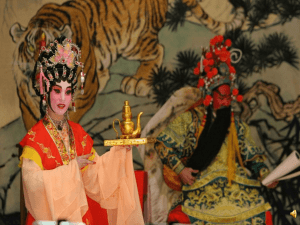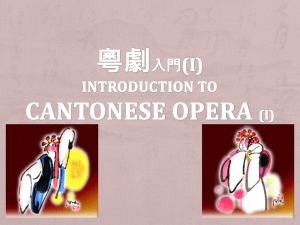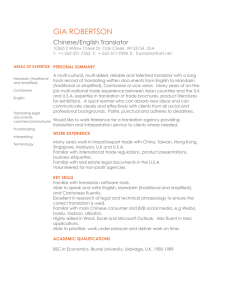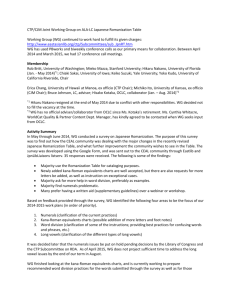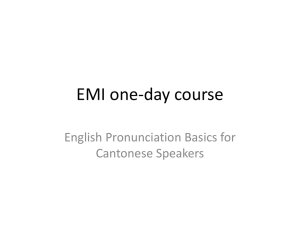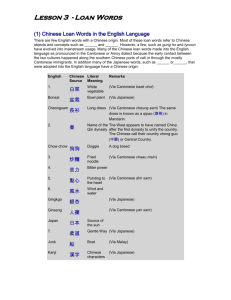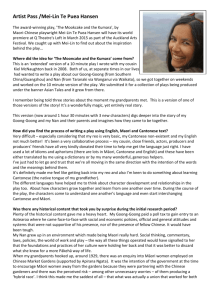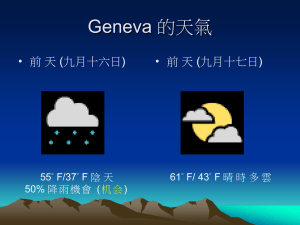Cantonese Romanization Systems
advertisement
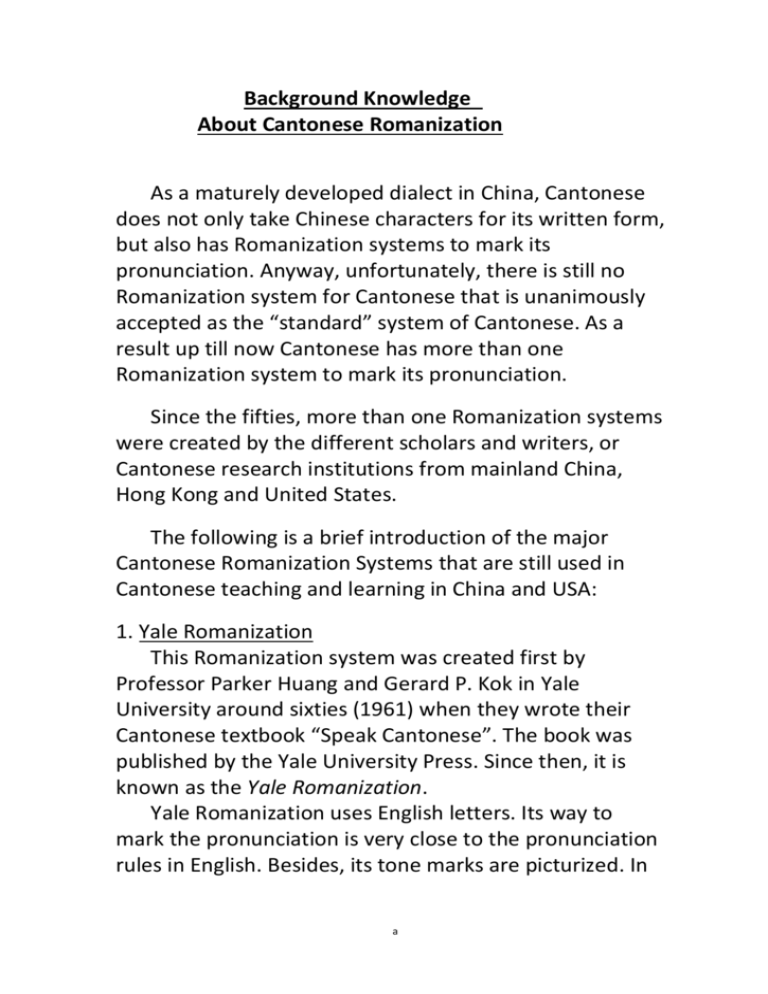
Background Knowledge About Cantonese Romanization As a maturely developed dialect in China, Cantonese does not only take Chinese characters for its written form, but also has Romanization systems to mark its pronunciation. Anyway, unfortunately, there is still no Romanization system for Cantonese that is unanimously accepted as the “standard” system of Cantonese. As a result up till now Cantonese has more than one Romanization system to mark its pronunciation. Since the fifties, more than one Romanization systems were created by the different scholars and writers, or Cantonese research institutions from mainland China, Hong Kong and United States. The following is a brief introduction of the major Cantonese Romanization Systems that are still used in Cantonese teaching and learning in China and USA: 1. Yale Romanization This Romanization system was created first by Professor Parker Huang and Gerard P. Kok in Yale University around sixties (1961) when they wrote their Cantonese textbook “Speak Cantonese”. The book was published by the Yale University Press. Since then, it is known as the Yale Romanization. Yale Romanization uses English letters. Its way to mark the pronunciation is very close to the pronunciation rules in English. Besides, its tone marks are picturized. In a many of the learning and teaching practices, this system is found easier to acquire by English speakers. Example: 我哋都好中意學廣東話。 Ngóh deih dōu hóu jūng yi hohk Gwóng-dūng-wá. (We all like to learn Cantonese.) There are quite a few textbooks or dictionaries that use Yale Romanization. They include: 1. “Colloquial Cantonese --- The Complete Course for Beginners” by Keith S. T. Tong and Gregory James This textbook is published by Routledge. 2. “A Dictionary of Cantonese Slang --- The Language of Hong Kong Movies, Street Gangs and City Life” by Christopher Hutton and Kingsley Bolton. This dictionary is published by University of Hawai’I Press, Honolulu. 3. “Cantonese Colloquial Expressions” (廣州話口語詞 彙) by Lo Tam Fee-yin. This dictionary is published by the Chinese University Press. 4. “Learn Chinese Characters in Hon Kong” by Chan Kwok Kin and William Crewe. This dictionary/textbook is published by Greenwood Press. 5. “Read and Write Chinese --- A simplified Guide to The Chinese Characters” by Rita Mei-Wah Choy. This dictionary is published by China West Book. 6. “Interesting Cantonese Colloquial Expressions” by Lo Wood Wai and Tam Fee Yin. This book was b published by the Chinese University Press. It is out of print now. 7. It is also being used now by an on-line Cantonese in put software at http://cpime.hk/ 2. Sidney Lau’s Romanization This Romanization system was created first by Sidney Lau when he wrote his textbook “Elementary Cantonese” “Intermediate Cantonese” and “Advanced Cantonese”. The books were published in seventies (1972) by the then Hong Kong government. This system uses the similar way to mark most of the finals (except for euh/eu, oh/o, oo/u, ooi/ui, oot/ut, ui/eui, un/eun, ut/eut) and initials as of the Yale Romanization. But it uses numbers for its tones like the Jyutping Romanization and the Guongjeowa Romanization. Example: 我哋都好中意學廣東話。 Ngoh5 dei6 dou1 hou2 jung1 yi3 hok6 Gwong2-dung1-wa2. (We all like to learn Cantonese.) It is being used now by an on-line Cantonese in put software at http://cpime.hk/ 3. Jyutping Romanization This Romanization system was created in 1993 by the Hong Kong Linguistics Association (香港語言學學 c 會)in its “Plan for Cantonese Romanization” (粵語拼音 方案). This Romanization system’s finals are mostly the same as the Yale Romanization except for five of them (oe/eu, eoi/eui, eon/eun, oeng/eung, eot/eut, oek/euk.) As for its tone marks, it uses numbers. Example: 我哋都好中意學廣東話。 Ngo5 dei6 dou1 hou2 jung1 yi3 hok6 Gwong2-dung1-wa2. (We all like to learn Cantonese.) It is used by Zhan Bohui (詹伯慧)and Qiu Xueqiang (丘 學強) in their Cantonese textbook “Xinshikong Yueyu” (新 時空粵語”) published by the Jinan University Press (暨南 大學出版社). It is also being used now by an on-line Cantonese in put software at http://cpime.hk/ 4. Guongjeowa Romanization This Romanization system was created in 1981 by 饒秉才(Rao Bingcai), 歐陽覺亞 (Ouyang Jueya) and 周 無忌 (Zhou Wuji) in their book 廣州話方言詞典 (Gwongjeowa Dialect Dictionary) published by 香港商 務印書館(the Hong Kong Commercial Printing Press). d The marks for many of the finals in this Romanization system are very different from the other three Romanization system mentioned above. As for its tone marks, it uses numbers. Example: 我哋都好中意學廣東話。 Ngo5 déi6 dou1 hou2 jung1 yi3 hog6 Guong2-dung1-wa2. (We all like to learn Cantonese.) It is used by 鄭定歐 (Zheng Dingou), 張勵妍 (Zhang Liyan) and 高石英(Gao Shiying) in their Cantonese textbook “粵語 (香港話)教程” (“Yueyu <Xiangganghua> Jiaocheng”) published by Joint Publishing (H.K.) Co., LTD. (三聯書店(香港) 有限公司). The textbooks chosen by the Cantonese courses at Cornell University use the above mentioned Romanization systems. These Cantonese Romanization systems are the useful tools in the Cantonese teaching and learning at Cornell University. It is hoped that the students will be benefited from the acquisition of these major Cantonese Romanization Systems not only for their Cantonese learning at Cornell University but also for their future learning or work outside Cornell University. e

